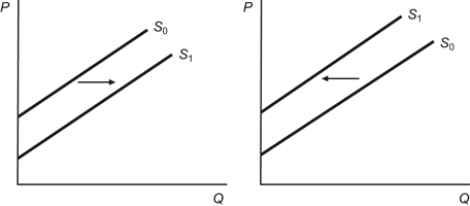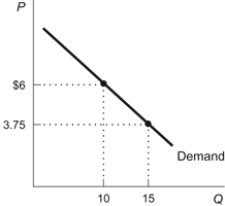A) As incomes increase, people consume more of all goods.
B) The demand for a good increases with the number of consumers in the market.
C) As the price of a good increases, consumers purchase less of that good.
D) The supply of a good increases in proportion to the demand for it.
Correct Answer

verified
Correct Answer
verified
Multiple Choice
A farmer can grow soy or sorghum. If the price of soy increases, the opportunity cost of growing sorghum ______, shifting the supply curve of sorghum ______.
A) decreases; up and to the left
B) increases; up and to the left
C) decreases; down and to the right
D) increases; down and to the right
Correct Answer

verified
Correct Answer
verified
Multiple Choice
The quantity supplied of oil is the amount that:
A) producers plan to sell during a given time period at a given price.
B) is actually bought during a given time period at a given price.
C) producers wish they could sell at a higher price.
D) people are willing to buy during a given time period at a given price.
Correct Answer

verified
Correct Answer
verified
True/False
A change in price is reflected by a movement along the same demand curve while a change in demand refers to a shift of the entire demand curve.
Correct Answer

verified
Correct Answer
verified
Multiple Choice
If romaine lettuce and iceberg lettuce are substitutes, a(n) _____ in the price of romaine lettuce will ______ the demand for iceberg lettuce.
A) increase; decrease
B) increase; increase
C) decrease; increase
D) decrease; not change
Correct Answer

verified
Correct Answer
verified
Multiple Choice
Firms are willing and able to sell 100 guitars per day at a price of $250 per guitar. What price will firms require to sell 100 guitars per day if there is a tax of $15 per guitar?
A) $235
B) $250
C) between $235 and $250
D) $265
Correct Answer

verified
Correct Answer
verified
Multiple Choice
Weather forecasters predict that a major winter storm will strike your town within the next few days. Which would occur today based upon the expected storm?
A) a decrease in peoples' willingness to pay for bottled water
B) a decrease in demand for batteries
C) an increase in people's willingness to pay for electric generators
D) a shift to the left of the demand curve for snow tires
Correct Answer

verified
Correct Answer
verified
Multiple Choice
Which of the following statements about the supply curve is TRUE?
A) As the price of a good rises, it becomes profitable to sell the higher-cost good.
B) As the price of a good rises, it becomes profitable to sell only the lower-cost good.
C) All sellers are willing to sell a good only when the price is very high.
D) All sellers are able to sell a good only when the price is very low.
Correct Answer

verified
Correct Answer
verified
Multiple Choice
The quantity supplied:
A) shows how much buyers are willing and able to buy at different prices.
B) is the amount that buyers are willing and able to buy at a particular price.
C) shows how much sellers are willing and able to sell at different prices.
D) is the amount that sellers are willing and able to sell at a particular price.
Correct Answer

verified
Correct Answer
verified
Multiple Choice
Figure A: Supply Right Shift
Figure B: Supply Left Shift  Refer to the two figures. Which statement is TRUE?
Refer to the two figures. Which statement is TRUE?
A) Figure A depicts the expectation that the future price will decrease.
B) Figure A depicts an increase in taxes.
C) Figure B depicts falling input prices.
D) Figure B depicts technological innovations.
Correct Answer

verified
Correct Answer
verified
Multiple Choice
An increase in a per unit production subsidy ______ supply.
A) increases
B) decreases
C) does not change
D) changes in an indeterminate direction
Correct Answer

verified
Correct Answer
verified
True/False
Suppose that the market price for MP3 players is $90 and MP3 players can be produced by firm X for $40 each. Producer surplus for this firm is $50 per MP3 player.
Correct Answer

verified
Correct Answer
verified
Multiple Choice
A decrease in income causes demand for a normal good to ________, and an increase in income causes demand for an inferior good to ________.
A) decrease; decrease
B) increase; increase
C) decrease; increase
D) increase; decrease
Correct Answer

verified
Correct Answer
verified
Multiple Choice
Figure: Demand Curve  Which statement is TRUE regarding the figure?
Which statement is TRUE regarding the figure?
A) At a price of $6 per unit, consumers are willing and able to buy 10 units.
B) The maximum price demanders are willing to pay for 15 units is $6 per unit.
C) The higher the price, the greater the quantity demanded.
D) At a price of $3.75 per unit, consumers are indifferent between buying 10 and 15 units.
Correct Answer

verified
Correct Answer
verified
Multiple Choice
The average age in the United States is _____, causing the demand for prescription drugs to _____.
A) increasing; decrease
B) increasing; increase
C) decreasing; increase
D) decreasing; decrease
Correct Answer

verified
Correct Answer
verified
Multiple Choice
If, for a given amount of a good or service, willingness to pay decreases, then:
A) supply has increased.
B) supply has decreased.
C) demand has increased.
D) demand has decreased.
Correct Answer

verified
Correct Answer
verified
True/False
Other things being equal, total consumer surplus falls when the market price rises.
Correct Answer

verified
Correct Answer
verified
Multiple Choice
In the oil market, an increase in the wage of oil workers will shift the:
A) supply curve of oil to the right.
B) supply curve of oil to the left.
C) demand curve for oil to the left.
D) demand curve for oil to the right.
Correct Answer

verified
Correct Answer
verified
Multiple Choice
In 2011, the United States Senate voted to end ethanol subsidies. What will be the effect of this bill in the market for ethanol?
A) Demand will increase
B) Demand will decrease
C) Supply will decrease
D) Supply will increase
Correct Answer

verified
Correct Answer
verified
Multiple Choice
Consider the (world) market supply curve for oil. Saudi oil production inhabits the _____ part of the curve, and Canadian oil production inhabits the _____ part of the curve.
A) upper; upper
B) lower; lower
C) upper; lower
D) lower; upper
Correct Answer

verified
Correct Answer
verified
Showing 141 - 160 of 255
Related Exams